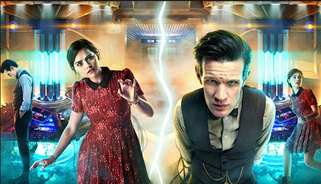
Unfortunately despite moments of brilliance, and a few beautiful sets, this once did not buck the trend and was largely the Doctor wandering around corridors while being chased by a fantastic looking but poorly realised and fleshed out monster. Again.
At least here they'd built custom sets for the TARDIS. Even though they were mainly corridors (and seriously – where were all the roundels? There’s been raging arguments about the lack of roundels since The Invasion Of Time – maybe this oversight was a way to engage with older viewers in time for the 50th?). That said the library, with its liquid based encyclopaedias, looked amazing. Even though it looked like it was a refugee from the Harry Potter films. The replicator room was also amazing looking - I'm hoping to see that again in future. There were also a few nice references to previous episodes - you got to see The Doctor's cot again, the toy TARDIS Mel and Amy played with as children, and Sylvester McCoy's umbrella as Clara ran from room to room.
| However, much like the Wizard of Oz, when you pull back the curtains and reveal the mystery of the TARDIS you lose far more than you gain. Actually the whole episode had a Wizard of Oz theme with a young woman getting lost in a strange magical land and having to be rescued by a trio of companions, one of who was a tin man! | The episode lacks the carefully crafted storytelling I've come to expect from Moffat's era. |
The salvage team were also poorly realised, and the reveal that the android was actually a human felt rushed and pointless. And the lava zombies, or the TARDIS turning on the Doctor and company, were never fully explained. Why were they chasing them around the ship? This is the third episode this series were a fantastic costume has been wasted on an enemy that feels under written and poorly established as a threat.
In fact the entire episode felt like one from Russell T Davies era where every idea he had, whether fully realised or not, was thrown into a big melting pot. The episode (and indeed this whole series) lacks the carefully crafted storytelling I've come to expect from Moffat's era.
In conclusion, it was a perfectly adequate episode, with some nice references and call backs to earlier Who episodes (both recent and classic), a smattering of nice set pieces, and good performances all round but like so much of the latest series it was lacking the final polish I've come to expect from Doctor Who. And it ended with the reset button being pressed (literally), the worst kind of ending for serial storytelling, which made it all the more pointless as it didn’t even happen!
Gareth


 RSS Feed
RSS Feed
